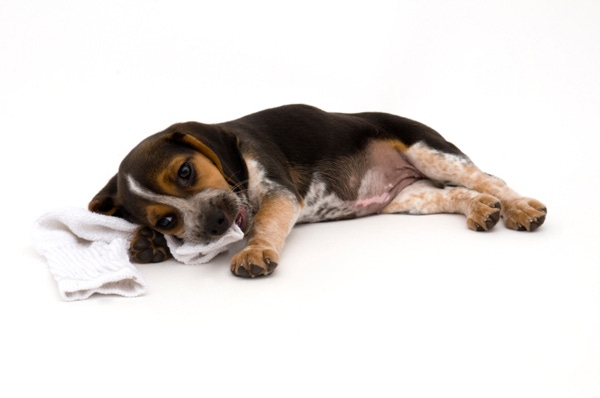A 2008 study showed that dogs' and cats' toxic loads are often substantially higher and more varied than those of their human owners. So how can you take care of your pets and Mother Nature? Here are four ways to start.

Even when the rest of the family has gone green, Fluffy and Fido are often left to wreak a surprisingly massive toll on the environment. The estimated 10 million tons of waste produced each year by dogs and cats have a particularly devastating impact: Unbagged excrement can contaminate groundwater and soil with disease-carrying bacteria and parasites, while bagged waste stagnates in landfills. Meanwhile, pets are often exposed to dangerous levels of toxins because of the food and product choices we make for them. A 2008 study showed that dogs' and cats' toxic loads are often substantially higher and more varied than those of their human owners. So how can you take care of your pets and Mother Nature? Here are four ways to start.
Tip #1: Make their toys
Many foreign-made pet products contain lead and cadmium — which can harm animals who chew on and ingest their toys, says Will Falconer, DVM, a homeopathic veterinarian in Austin, Texas. “Over time, small amounts of these heavy metals can affect the nervous system, red blood cells, and bowels, and can even cause death,” he says. Protect your furry friends by giving them durable, nontoxic, U.S.-made products. Some imagination, organic cotton or wool stuffing, and a sewing machine can transform old jeans — or another durable cotton fabric that will hold up against sharp teeth — into chew toys your pet will love. For the less crafty, gently used socks (no holes!) make it easy to create colorful sock animals. For information about environmentally responsible playthings, see “Safe Products for Pets,”, or find ideas in Eco Dog by Corbett Marshall and Jim Deskevich (Chronicle, 2008).
Tip #2: Feed them organic
Ever since pet food tainted with melamine sickened and killed U.S. dogs and cats in 2007, consumers have become increasingly discriminating when it comes to store-bought pet grub. Although the affected food was recalled, there are other reasons to choose chow wisely. Besides exposing your animal companions to added growth hormones, antibiotics, and synthetic fertilizers, the agricultural implications (think pesticide runoff) of producing conventional kibble's vegetable and meat proteins can also threaten soil and water quality. Choose USDA Organic pet nosh, which meets the same standards as certified-organic human food. Or talk with your veterinarian about making Spot's food from scratch. Cats and dogs require specific mixes of nutrients that vary by animal type, breed, and age. “But as long as it's nutritionally balanced, homemade food is much healthier than anything found in a can or bag because dogs' and cats' digestive systems process fresh, raw food better than cooked food,” says Falconer. “Feeding them balanced raw diets will also increase their bodies' resistance to worms.” Once you've gotten the OK from your vet, find recipes and ideas in Dr. Pitcairn's New Complete Guide to Natural Health for Dogs and Cats by Richard H. Pitcairn, DVM, PhD, and Susan Hubble Pitcairn (Rodale, 2005).
Tip #3: Pitch poop properly
Though your pet's feces should never find their way into your compost pile, Doggie Dooley and NatureMill offer pet-specific systems that use enzymes and heat to destroy harmful pathogens and convert waste into safe fertilizer. Or bury your pooch's backyard droppings away from vegetable gardens and water sources to avoid human exposure to pathogens, advises Tom Watson, project manager for Seattle's King County Recycling and Environmental Services. When you're out and about, dispose of waste in biodegradable poop baggies made from cornstarch plastic, such as those from BioBag. (The company also offers biodegradable cat-pan liners.) Even though landfill conditions prevent the bags from breaking down quickly, plastic made from cornstarch is a more sustainable choice than petroleum-based polyethylene.
Kitty poop should always be bagged and tossed in the trash because it can harbor an infectious parasite detrimental to fetuses and people with weak immune systems. However, most of the 2 million tons of nonbiodegradable kitty litter sent to landfills annually contains quartz silica — recognized by the California Environmental Protection Agency as a human and pet carcinogen. A good option for cat lovers: biodegradable litter made from recycled newspaper, sawdust pellets, and corn. Or try chemical-free, wheat-based Swheat Scoop litter, available in natural markets. To absorb odors, dust litter with baking soda.
Tip #4: See to fleas
Conventional pest prevention and treatment options are far worse for animals' and people's health than the actual bugs are, says Jen Sass, PhD, a senior scientist and toxicologist at the National Resources Defense Council (NRDC). The NRDC estimates that “hundreds and probably thousands” of pets have been injured or killed because of exposure to the pesticides found in flea collars, aerosol sprays, and other pest-control products. “The Environmental Protection Agency has also acknowledged that these products expose children to unsafe chemicals because kids touch, rub, kiss, and sleep with their pets,” she says.
Rather than using products that contain carbaryl, propoxur, and tetrachlorvinphos, sprinkle brewer's yeast, fresh garlic, or flaxseed oil in your pet's food — fleas hate the smell and taste, Sass says. Fleas also detest the smell of pennyroyal, lavender, mint, rosemary, sweet woodruff, and cedar. So either tie a bandanna filled with these pungent herbs around your pet's neck, or rub the dry herbs into your pet's coat. You can also purchase herbal flea collars at many health food and pet stores. If fleas have infested your home, sprinkle all pet beds and carpets with boric acid salts, which kill flea larvae without hurting people or pets, Falconer says.
About the Author(s)
You May Also Like




